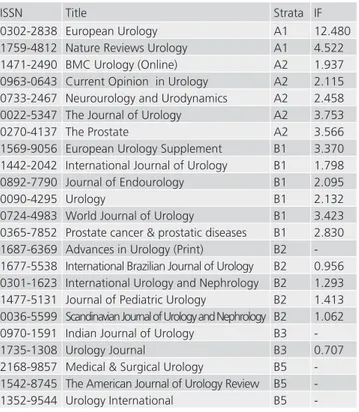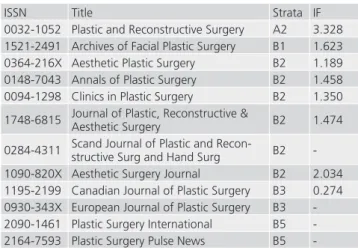68 Original Article
Rev. Col. Bras. Cir. 2015; 42(Suplemento 1): 68-69
JOURNALS ANALYSIS IN UROLOGY AND PLASTIC SURGERY
Análise dos periódicos da urologia e cirurgia plástica
a
Lbertoa
zoubeLa
ntunesINTRODUCTION
T
he Qualis system is defined by the Higher Education Personnel Improvement Coordination (Capes) as a list of vehicles used for the dissemination of the intellectual production of stricto sensu postgraduate programs1. Cur-rently represents the main measure of quality of postgraduate product.However, when different areas of knowledge are compared, the different journals profiles found difficulties in establishing uniform evaluation criteria. Thus, it is extremely important knowledge of both culture and publishing habits of each area, as well as the quality of the journals in each specialty.
The aim of this analysis was to underline the main jour-nals used in Urology and Plastic Surgery.
METHODS
To identify the most used journals by urologists and plastic surgeons was consulted the WebQualis database2. Was select the option “consult” after the “rating” and finally by “journal title.” From this point were used some keywords to identify the journals: urology, urologic, urological, prostate, prostatic, plastic, reconstructive, aesthetic. The journals clas-sified in the Medicine III Capes area were selected, and their respective strata were recorded.
For confirmation of the 2014 impact factor (IF), was consulted the database http://www.impactfactorsearch.com/3 typing the journal name and automatically revealing its IF.
RESULTS
Were found 23 journals in Urology and 12 in Plastic Surgery. The average impact factor of urological journals was 2,256 and in Plastic Surgery 1,060. Among the urological journals, seven (30.4%) were in the A WebQualis rating and among Plastic Surgery only one (8.3%) was found in this stratum. (Figures 1 e 2).
Table 1 describes the Urology journals with their respec-tive strata and IF, and Table 2 the journals in Plastic Surgery.
FIGURE 1 - Qualis Urology journals distribution according to the strata of the Qualis system
TABLE 1 - Main journals in Urology with their respective strata and IF (ISI 2014)
ISSN Title Strata IF 0302-2838 European Urology A1 12.480 1759-4812 Nature Reviews Urology A1 4.522 1471-2490 BMC Urology (Online) A2 1.937 0963-0643 Current Opinion in Urology A2 2.115 0733-2467 Neurourology and Urodynamics A2 2.458 0022-5347 The Journal of Urology A2 3.753 0270-4137 The Prostate A2 3.566 1569-9056 European Urology Supplement B1 3.370 1442-2042 International Journal of Urology B1 1.798 0892-7790 Journal of Endourology B1 2.095 0090-4295 Urology B1 2.132 0724-4983 World Journal of Urology B1 3.423 0365-7852 Prostate cancer & prostatic diseases B1 2.830 1687-6369 Advances in Urology (Print) B2 -1677-5538 International Brazilian Journal of Urology B2 0.956 0301-1623 International Urology and Nephrology B2 1.293 1477-5131 Journal of Pediatric Urology B2 1.413 0036-5599 Scandinavian Journal of Urology and Nephrology B2 1.062 0970-1591 Indian Journal of Urology B3 -1735-1308 Urology Journal B3 0.707 2168-9857 Medical & Surgical Urology B5 -1542-8745 The American Journal of Urology Review B5 -1352-9544 Urology International B5
-From the Disciplina de Urologia, Faculdade de Medicina, Universidade de São Paulo (Discipline of Urology, School of Medicine, São Paulo University), São Paulo, SP, Brazil
DOI: 10.1590/0100-69912015S01024
A B S T R A C T
Objective: Find out the main journals used in Urology and Plastic Surgery. Methods: Was consulted the WebQualis database and selected the “consult” after the “rating” and finally by “journal title.” Also was crossed the following keywords: urology, urologic, urological, prostate, prostatic, plastic, reconstructive, aesthetic. The journals classified in the field of Capes Medicine III were selected, and registered their respective strata. To confirm the 2014 impact factor, was consulted the http://www.impactfactorsearch.com/ database; simply typing the journal title its impact factor appears automatically. Results: Was found 23 journals in Urology and 12 in Plastic Surgery. The average impact factor of urological journals was 2,256 and in Plastic Surgery 1,060. Among the urological journals, seven (30.4%) were in the A WebQualis rating and among Plastic Surgery only one (8.3%) was found in this stratum. Conclusion: There are quantitative and qualitative differences between journals in Urology and Plastic Surgery. These data can help to develop appropriate assessment methods for each specialty, considering the different features of the presented papers.
69 Original Article
Rev. Col. Bras. Cir. 2015; 42(Suplemento 1): 68-69
69
DISCUSSION
Knowledge of journals in each specialty is of fundamental importance for the development of reliable and accurate evalu-ation methods. This survey revealed that Urology has superiority to Plastic Surgery with regard to the quantity and quality of the periodic reviews. This fact becomes clear when we note that while only one journal in Plastic Surgery was classified in stratum Qualis A, seven in Urology are in this stratum. This fact complicates the assessment of researchers working in the field of Urology and Plastic Surgery by the same criteria.
The limitations of this analysis is that we highlight the fact that there are a lot of interface among medical specialties, enabling urologists to publish in journals of Nephrology (eg arti-cles on kidney transplant), geriatrics, oncology, and even Plastic Surgery, and they are not counted in this survey. Likewise, plastic surgeons can publish in Head and Neck Surgery journals, Neu-rosurgery, or in surgical and reconstructions specialties involving mutilating operations.
We cannot forget the journals of general medicine, which can be the focus of any specialty that addresses issues of great medical interest. In general these journals have IF much higher because they have greater penetration in the general medical community and are read and cited by more doctors and research-ers. New England Journal of Medicine, JAMA, Nature, Science, etc. are highlighted
CONCLUSION
There are quantitative and qualitative differences between urologic and Plastic Surgery journals. This data can help to devel-op evaluation methods suitable for each specialty, considering the different characteristics of the presented jounals.
FIGURE 2 – Plastic Surgery journals distribution according to the strata of the Qualis system
TABLE 2 - Main journals in Plastic Surgery with their respective strata and IF (ISI 2014)
ISSN Title Strata IF 0032-1052 Plastic and Reconstructive Surgery A2 3.328 1521-2491 Archives of Facial Plastic Surgery B1 1.623 0364-216X Aesthetic Plastic Surgery B2 1.189 0148-7043 Annals of Plastic Surgery B2 1.458 0094-1298 Clinics in Plastic Surgery B2 1.350 1748-6815 Journal of Plastic, Reconstructive &
Aesthetic Surgery B2 1.474 0284-4311 Scand Journal of Plastic and
Recon-structive Surg and Hand Surg B2 -1090-820X Aesthetic Surgery Journal B2 2.034 1195-2199 Canadian Journal of Plastic Surgery B3 0.274 0930-343X European Journal of Plastic Surgery B3 -2090-1461 Plastic Surgery International B5 -2164-7593 Plastic Surgery Pulse News B5
-REFERENCES
1. O novo Qualis, ou a tragédia anunciada. Rocha-e-Silva, M; Clin-ics (São Paulo) 2009; 64(1): 1 -4.
2. http://qualis.capes.gov.br/webqualis. Acesso em dezembro de 2014. 3. http://www.impactfactorsearch.com/ Acesso em dezembro de 2014.
Received on: 19/02/2015
Accepted for publication: 12/09/2015 Conflict of interest: none
Source of funding: Address for correspondence: Alberto Azoubel Antunes antunesuro@uol.com.br
R E S U M O
Objetivo: Procurar destacar os principais periódicos utilizados na urologia e na cirurgia plástica. Métodos: Foi consultada a base de dados WebQualis. Selecionou-se a opção “consultar”, depois a opção “classificação” e por fim por “título do periódico”. Cruzaram-se também os seguintes descritores: urology, urologic, urological, prostate, prostatic, plastic, reconstructive, aesthetic. Os periódicos classificados na área da Medicina III da Capes foram selecionados, e seus respectivos estratos registrados. Para confirmação do fator de impacto de 2014, consultou-se a base de dados http://www.impactfactorsearch.com/, onde a digitação do nome do periódico revela automaticamente seu impacto. Resultados: Foram encontrados 23 periódicos urológicos e 12 na cirurgia plástica. O fator de impacto médio dos urológicos foi de 2.256 e o da cirurgia plástica de 1.060. Entre os periódicos urológicos, sete (30,4%) encontravam-se no estrato A do Qualis e entre os da cirurgia plástica apenas um (8,3%) encontrava-se neste estrato. Conclusão: Existem diferenças quan-titativas e qualitativas entre os periódicos urológicos e os da cirurgia plástica. Estes dados podem auxiliar na elaboração de métodos de avaliação adequados para cada especialidade, considerando-se as diferentes características dos periódicos apresentados.

